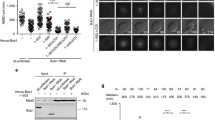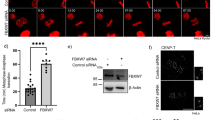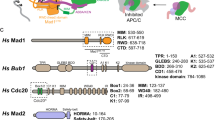Abstract
The mitotic arrest deficiency 2 (Mad2) protein is an essential component of the spindle assembly checkpoint that interacts with Cdc20/Slp1 and inhibit its ability to activate anaphase promoting complex/cyclosome (APC/C). In bladder cancer cell line the C-terminal residue of the mad2 gene has been found to be deleted. In this study we tried to understand the role of the C-terminal region of mad2 on the spindle checkpoint function. To envisage the role of C-terminal region of Mad2, we truncated 25 residues of Mad2 C-terminal region in fission yeast S.pombe and characterized its effect on spindle assembly checkpoint function. The cells containing C-terminal truncation of Mad2 exhibit sensitivity towards microtubule destabilizing agent suggesting perturbation of spindle assembly checkpoint. Further, the C-terminal truncation of Mad2 exhibit reduced viability in the nda3-KM311 mutant background at non-permissive temperature. Truncation in mad2 gene also affects its foci forming ability at unattached kinetochore suggesting that the mad2-∆CT mutant is unable to maintain spindle checkpoint activation. However, in response to the defective microtubule, only brief delay of mitotic progression was observed in Mad2 C-terminal truncation mutant. In addition we have shown that the deletion of two β strands of Mad2 protein abolishes its ability to interact with APC activator protein Slp1/Cdc20. We purpose that the truncation of two β strands (β7 and β8) of Mad2 destabilize the safety belt and affect the Cdc20-Mad2 interaction leading to defects in the spindle checkpoint activation.






Similar content being viewed by others
References
Amon A (1999) The spindle checkpoint. Curr Opin Genet Dev 1:69–75
Musacchio A (2015) The molecular biology of spindle assembly checkpoint signaling dynamics. Curr Biol 25:R1002–R1018
Musacchio A, Salmon ED (2007) The spindle-assembly checkpoint in space and time. Nat Rev Mol Cell Biol 8:379–393
Kimata Y, Baxter J, Fr AM, Yamano H (2008) A role for the Fizzy/Cdc20 family of proteins in activation of the APC/C distinct from substrate recruitment. Mol Cell 21:576–583
Peters JM (2006) The anaphase promoting complex/cyclosome: a machine designed to destroy. Nat Rev Mol Cell Biol 7:644–656
Heinrich S, Windecker H, Hustedt N, Hauf S (2012) Mph1 kinetochore localization is crucial and upstream in the hierarchy of spindle assembly checkpoint protein recruitment to kinetochores. J Cell Sci 125:4720–4727
Hoyt MA, Totis L, Roberts BT (1991) S. cerevisiae genes required for cell cycle arrest in response to loss of microtubule function. Cell 66:507–517
Li R, Murray AW (1991) Feedback control of mitosis in budding yeast. Cell 66:519–531
Weiss E, Winey M (1996) The Saccharomyces cerevisiae spindle pole body duplication gene MPS1 is part of a mitotic checkpoint. J Cell Biol 132:111–123
Yu H (2007) Cdc20: a WD40 activator for a cell cycle degradation machine. Mol Cell 27:3–16
Luo X, Fang G, Coldiron M, Lin Y, Yu H, Kirschner MW, Wagner G (2000) Structure of the Mad2 spindle assembly checkpoint protein and its interaction with Cdc20. Nat Struct Biol 7:224–229
Luo X, Tang Z, Rizo J, Yu H (2002) The Mad2 spindle checkpoint protein undergoes similar major conformational changes upon binding to either Mad1 or Cdc20. Mol Cell 9:59–71
Sironi L, Mapelli M, Knapp S, De Antoni A, Jeang KT, Musacchio A (2002) Crystal structure of the tetrameric Mad1-Mad2 core complex: Implications of a ‘safety belt’ binding mechanism for the spindle checkpoint. EMBO J 21:2496–2506
Luo X, Tang Z, Xia G, Wassmann K, Matsumoto T, Rizo J, Yu H (2004) The Mad2 spindle checkpoint protein has two distinct natively folded states. Nat Struct Mol Biol 11:338–345
De Antoni A, Pearson CG, Cimini D, Canman JC, Sala V, Nezi L, Mapelli M, Sironi L, Faretta M, Salmon ED, Musacchio A (2005) The Mad1/Mad2 complex as a template for Mad2 activation in the spindle assembly checkpoint. Curr Biol 15(3):214–225
Chao WC, Kulkarni K, Zhang Z, Kong EH, Barford D (2012) Structure of the mitotic checkpoint complex. Nature 484:208–213
Lau DT, Murray AW (2012) Mad2 and Mad3 cooperate to arrest budding yeast in mitosis. Curr Biol 22:180–190
Li Y, Benezra R (1996) Identification of a human mitotic checkpoint gene: hsMAD2. Science 274:246–248
Hernando E, Orlow I, Liberal V, Nohales G, Benezra R, Cordon-Cardo C (2001) Molecular analyses of the mitotic checkpoint components hsMAD2, hBUB1 and hBUB3 in human cancer. Int J Cancer 95:223–227
Sotillo R, Hernando E, Diaz-Rodriguez E, Teruya-Feldstein J, CordonCardo C, Lowe SW, Benezra R (2007) Mad2 overexpression promotes aneuploidy and tumorigenesis in mice. Cancer Cell 11:9–23
Moreno S, Klar A, Nurse P (1991) Molecular genetic analysis of fission yeast Schizosaccharomyces pombe. Methods Enzymol 194:793–823
Ranjan R, Verma SK, Ahmed S (2010) Flag tag module for PCR based gene targeting. J Yeast Fung Res 1:165–169
Sonkar A, Yadav S, Ahmed S (2016) Cleavage and polyadenylation factor, Rna14 is an essential protein required for the maintenance of genomic integrity in fission yeast Schizosaccharomyces pombe. BBA Mol. Cell Res 1863(2):189–197
Verma S, Ranjan R, Kumar V, Siddiqi M, Ahmed S (2014) Wat1/pop3, a conserved WD repeat containing protein acts synergistically with checkpoint kinase Chk1 to maintain genome ploidy in fission yeast S.pombe. PLoS One 9(2):e89587
Yadav S, Verma S, Ahmed S (2011) DNA topoisomerase II mutant activates DNA damage checkpoint protein kinase Chk1 in fission yeast S. pombe. Genet Res 93:275–283
Eswar N, Webb B, Marti-Renom MA, Madhusudhan MS, Eramian D et al (2006) Comparative protein structure modeling using modeller. Curr Protoc Bioinform. doi:10.1002/0471250953.bi0506s15
DeLano WL (2002) The PyMOL Molecular Graphics System. DeLano Scientific, San Carlos
Robert X, Gouet P (2014) Deciphering key features in protein structures with the new ENDscript server. Nucl Acids Res 42(W1):W320–W324
Hiraoka Y, Toda T, Yanagida M (1984) The NDA3 gene of fission yeast encodes beta-tubulin: a cold-sensitive nda3 mutation reversibly blocks spindle formation and chromosome movement in mitosis. Cell 39:349–358
Cleveland DW, Mao Y, Sullivan KF (2003) Centromeres and kinetochores: from epigenetics to mitotic checkpoint signaling. Cell 112:407–421
Horikoshi Y, Habu T, Matsumoto T (2013) An E2 enzyme Ubc11 is required for ubiquitination of Slp1/Cdc20 and spindle checkpoint silencing in fission yeast. Cell Cycle 12:961–971
Bahler J, Wu JQ, Longtine MS, Shah NG, McKenzie A (1998) Heterologous modules for efficient and versatile PCR-based gene targeting in Schizosaccharomyces pombe. Yeast 14:943–951
Mapelli M, Massimiliano L, Santaguida S, Musacchio A (2007) The MAD2 Conformational dimer: structure and implications for the spindle assembly checkpoint. Cell 131:730–743
Yang M, Bing L, Liu C, Tomchick DR, Machius M, Rizo J, Yu H, Luo X (2008) Insights into Mad2 regulation in the spindle checkpoint revealed by the crystal structure of the symmetric Mad2 dimer. PLoS Biol 6(3):e50
Kulkarni KA, Chao WCH, Zhang Z, Barford D (2012) Structure of the mitotic checkpoint complex. Nature 484:208–213
To-Ho KW, Cheung HW, Ling M, Wong Y, Wang X (2008) MAD2∆C induces aneuploidy and promotes anchorage-independent growth in human prostate epithelial cells. Oncogene 27:347–357
Acknowledgments
We thank Dr. JV Pratap, for critical reading of this manuscript and helpful discussion. We also thank Sophisticated Analytical Instrument Facility (SAIF) of CDRI for FACS analysis. This study was supported by a grant from Council of Scientific and Industrial Research (BSC0103 and BSC0121), New Delhi, India. The CDRI communication number for this manuscript is 9323.
Author information
Authors and Affiliations
Corresponding author
Rights and permissions
About this article
Cite this article
Singh, G.K., Karade, S.S., Ranjan, R. et al. C-terminal region of Mad2 plays an important role during mitotic spindle checkpoint in fission yeast Schizosaccharomyces pombe . Mol Biol Rep 44, 89–96 (2017). https://doi.org/10.1007/s11033-016-4083-y
Received:
Accepted:
Published:
Issue Date:
DOI: https://doi.org/10.1007/s11033-016-4083-y




